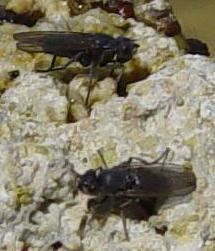Suborder Brachycera Rank Species | Order Diptera Section Schizophora | |
 | ||
Similar Artemia monica, Ephydridae, Ochthera, Helaeomyia petrolei, Ephydroidea | ||
Ephydra hians, common name the alkali fly, is a species of fly in the family Ephydridae, the brine flies.
Contents
Description
The body of this species is dark brown. The thorax reflects a metallic greenish or bluish colour. It grows to 4 to 7 millimetres in length. The wings are smokey brown.
Larva
The larva contains a membranous cephalic area, the rest of the body is divided into 3 thoracic segments and 8 abdominal segments.
Distribution
This species is found mostly in the northwestern United States, as well as in Canada and Mexico. The habitat with the greatest number is in the Mono Basin in California. Other concentrations of this species are found in Minnesota, North Dakota, and Washington.
Habitat and behaviour
Ephydra hians live in the benthic-littoral zone in both soft and hard substrates. Throughout the summertime, the flies, which live for 3 to 5 days, lay eggs on or under the water's surface. These hatch in a short time. The larvae roam the bottom, underwater, feeding on algae and bacteria. They can remain under the water until they develop into adults. They do not need to go to the surface to breathe. They acquire oxygen supplied by photosynthesis of the algae. Once in the adult stage, the flies live for 3 to 5 days. They too are able to walk around under water to eat algae. They are able to do this by trapping air among the hairs on their body.
As food for humans
The Kucadikadi, a native American band, historically used the pupae of this fly as a source of protein and fat. The name "Kucadikadi" means "eaters of the brine fly pupae". Year round, but particularly in the summer, approximately 200 Kucadikadi harvested the pupae at Mono Lake. The pupae can be used to make stew after being dried. Considered a delicacy, the Kucadikadi also traded the pupae with others in the region.
